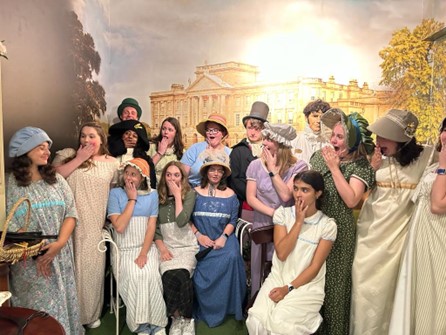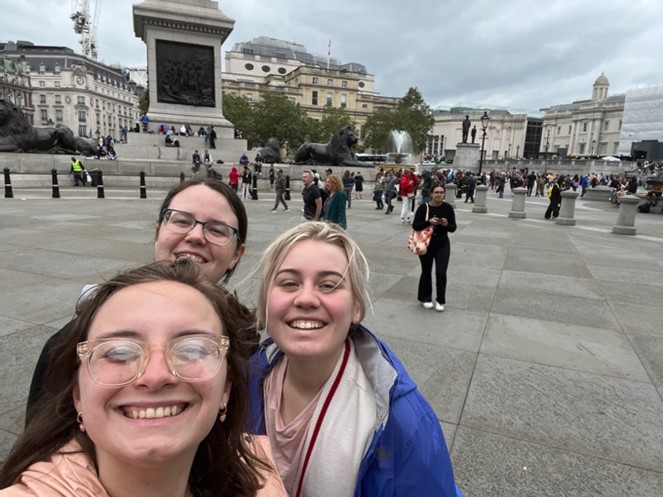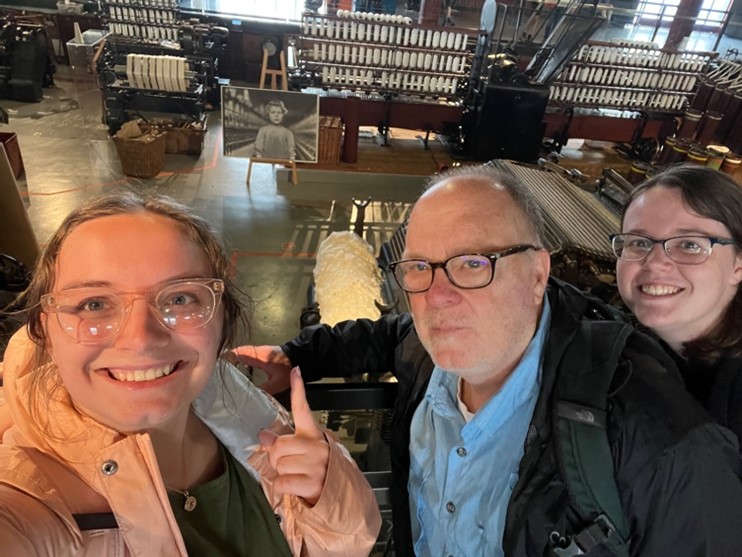Around Town – Class and Excursion
July 24, 2023
Chesani Askew | Political Science, Humanities and Social Sciences
By visiting the beautiful, historic city of Bath, I felt that I was able to immerse myself into the world of Persuasion and personally view the city as a “wealthy person’s playground.” While Oxford is an incredible city, the views at Bath were unparalleled. Before this excursion, I do not believe I had ever personally visited the physical site of any book I’ve read. This visit was a unique experience for both myself and my classmates to fully experience the historical world of Persuasion and contemplate how this extraordinary novel came to exist. After walking through the beautiful streets of Bath, visiting the Jane Austen center, and being able to wear Regency era clothing, it was simple to see how the novel came to life.
With our guided walking tour, we learned about the numerous places Jane Austen and her family lived while in Bath, as well as the city’s history as a place for the wealthy aristocrats. This image was taken along the Avon River during the tour. Although it had previously been raining (and absolutely drenching me and my friends), the views were no less striking and incredible. It was easy to see how this city would have been appreciated in 18th century English society.
While at the Jane Austen center, where we were able to learn about all facets of her amazing novels, my friends and I had the opportunity to dress up in Regency Era clothing. To say this experience was fun and hilarious is an understatement. Sneha’s choice to wear the Naval uniform earned her the nickname “Admiral,” which will most definitely continue until the end of this trip. This image displays our poses after the lady taking our pictures told everyone to look at me and appear as if they had been shocked. Naturally, I decided to show pride in whatever supposed action would have caused me to be the subject of such scandal.
This image shows me, Kristen, Anna Cate, Drew, Gabby, and Dr. Babcock about twenty minutes before we absolutely demolished unlimited tea and snacks in the pump room of the Roman Baths. This was an incredible experience, and while I am not a fan of tea, I felt like a true sophisticated British person. Sometimes, I still dream about the deviled egg sandwiches.


Anna Catherine Strong | Film and Political Science, Humanities and Social Sciences
Imperialism is not only an important piece of understanding England’s past, but also its present influences and makeup throughout its major cities. My favorite class discussions we had were about the imperialist history of England, and the effects that it has rippled to England’s present day. Though the ghosts of imperialism are found largely in the museums of London like the British Museum or the V&A, what struck me most was the ribbons of imperialism in the dining options in London. There is normally a multitude of cultures in large cities, but even stepping off of the coach I noticed there was a far greater influence of other countries on London than you would see in New York or D.C. The cultural hotspots that we found like Chinatown, Soho, and Covent Garden were layered with different cultures, many of whom were a part of England’s imperial past or adjacent to that history.
The two influences that struck me greatly were the amount of Middle Eastern and Indian restaurants that were not only established but revered in London’s dining scene. Although India was released from British rule in the late 1940s, there is still a distinct connection between the two countries, which was evident with the volume and quality of the shops, dining, and cross culture influence (teas, spices, “borrowed” artifacts and furniture styles). The middle eastern influences also draw connections between things we’ve spoken about in class like the Suez Canal.
The first picture is a kebab I had at a Middle Eastern restaurant named Le Bab, and the second photo is a bacon and egg naan I had at an Indian restaurant named Dishoom, along with the most amazing chai. Although these foods may feel tangential to the topics discussed in class, they helped me gain a greater understanding of how imperialism not only affected the countries that were absorbed, but how the culture in their capitol city was affected. The crossovers of the histories were often present in the restaurants through decorations or photos. These foods weren’t a spectacle or out of place, they were a part of a much greater community that came to be because of the imperialistic connections of their home country and England. The kebabs were especially interesting because it’s aggravatingly difficult to find a good kebab in Mississippi, so the idea that England gets amazing kebabs abound because they imperialized multiple Middle Eastern nations is unfair.


Gabby Womble | Chemistry, College of Science
Charles Dickens writes Hard Times to comment on how industrialization has dehumanized people and has led to an obsession over greed. However, not every experience can be illustrated in a novel. For the free weekend, I went to Manchester to walk around and visit major sights. The Manchester Science and Industry Museum talks about how industrialization affected the city and innovated the lives of the people there. Being able to view how large many of these machines were and how dangerous the conditions were, I could understand Dickens’ writings of people lacking empathy and not caring what happened to themselves or others. I found that if I was living in an industrial society like that one with large machines and lack of care for my physical well-being, I would have to learn to just show no emotions at all to get by and survive. Going to the Science and Industry Museum in Manchester put working in factories into perspective for me.
The Pre-Raphaelites is an art movement that moves away from how artists were taught at London’s Royal Academy; it was a move to more detail-oriented art with every stroke having a deeper meaning. The Manchester Art Museum was gorgeous with all sorts of artwork, but I especially loved Pre-Raphaelite artwork that I saw there. The Scapegoat was a piece by William Holman Hunt depicting a religious tradition from the bible where a goat with its horns wrapped in red cloth would be forced out of the community to go and repent for the community’s sins. I found this piece did an amazing job describing what the Pre-Raphaelites worked for in not only the detail in the background of the goat but also in the symbolism and the telling of a religious story. The paintings at the Manchester Art Museum let me see artwork I was learning in class how to analyze and helped find a deeper meaning and beauty toward them.
Vera Brittain wrote Testament of Youth telling of her experiences with grief and growth during World War I, and my experience at the British War Museum in London helped me take into perspective many of the things she and her friends and family likely experienced. By looking at items left behind, uniforms, and propaganda of the day, I was able to understand more how difficult it was living during that time: how every day you had no clue what was going to happen or when the war was going to end. To see items lost with no owners really reminded me the devastation war has and that some people do not even get to be put to rest in peace as no one even knows who they are sometimes. Going through the trench section also helped me think about the war from the soldier’s standpoint of how they are living and moving in their day to day lives. Overall, the British War Museum made me think about the horrors of war from a different perspective.

